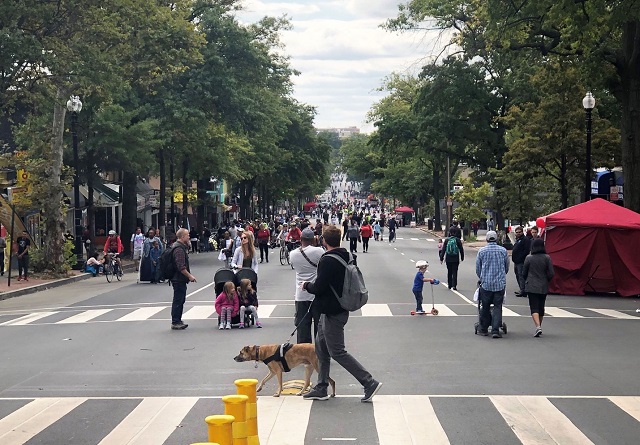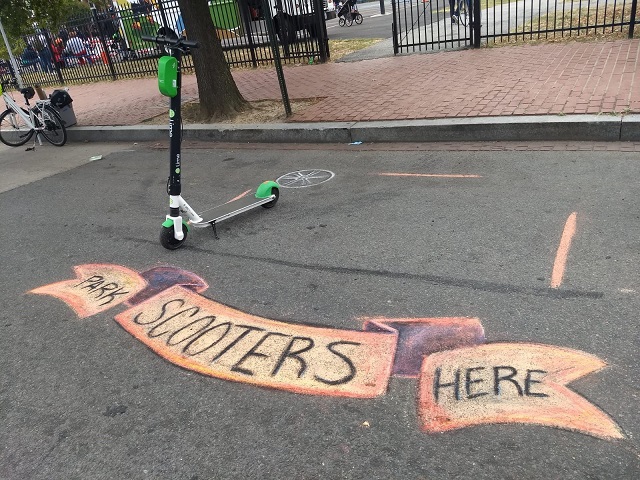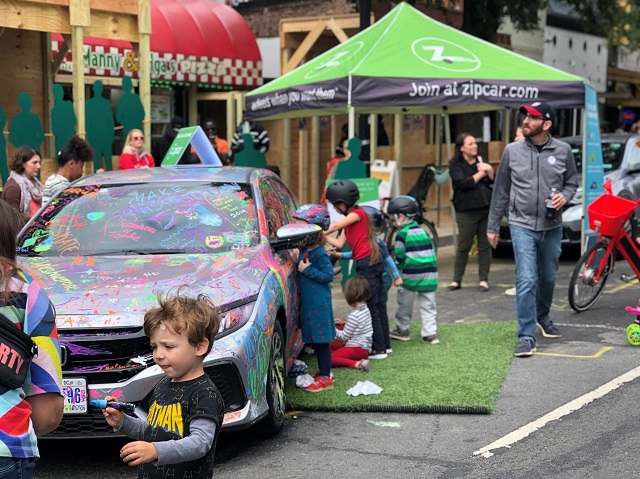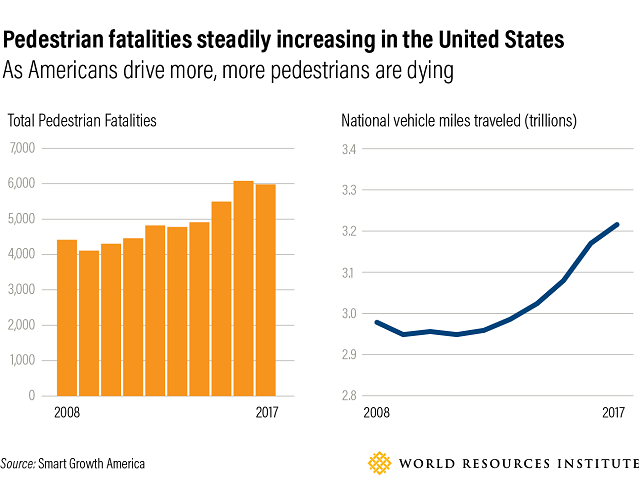
The view from Georgia Avenue just as people began to arrive at Open Streets DC. Photo by Madlyn McAuliffe/WRI
If asked what they were planning for Saturday afternoon, most residents of American cities wouldn’t say dancing in the middle of the street. Yet on October 5, that’s exactly what many did during Washington’s first ever Open Streets Day, which closed the normally busy Georgia Avenue to all cars for half the day. For nearly three glorious miles, residents and visitors alike explored a corridor of the city in an entirely new way that prioritized people, safety and joy over moving cars.
The crisp fall afternoon on a street devoid of cars marked a stark difference from the region’s norm as well as the national status quo. Transportation is the largest source of greenhouse gas emissions in the United States, and vehicle miles traveled continue to increase. Emissions from cars in the area have risen 39% since 1990, and while there is a silver lining in that emissions per person have decreased slightly between 1990 and 2017, the number of pedestrian fatalities increased by 35% from 2008 to 2017.
Meanwhile, the 2017 National Household Travel Survey found that nearly 30% of all trips are one mile or less, and more than 61% of those trips are taken by car. Many if not most of these short trips could be taken using public transit or lighter, less carbon-intensive modes including shared and electric scooters or bicycles.
Open Streets DC, part of Washington’s Vision Zero road safety pledge, was a reimagining of public streets as community spaces where participants could experience the city in a different way and without fear.
A First for DC
“We were one of the last [cities] to jump on the bandwagon because it was difficult to pull off,” said Anna Chamberlin, neighborhood planning manager at the District Department of Transportation.
Chamberlin and other city leaders were inspired by similar open streets events in cities around the world.
Bogotá pioneered the open streets concept with Ciclovía in the 1970s, but the idea has quickly spread globally, as escalating urbanization and motorization have caused an alarming increase in traffic fatalities and injuries. Raahgiri Day, started in the outskirts of New Delhi, is now celebrated in dozens of cities in India, and there are more than 130 Open Streets initiatives in the United States across 122 different municipalities.

A chalk-bound corral where electric scooter users could park their vehicles responsibly. Photo by Madlyn McAuliffe/WRI
Washington has been one of the foremost laboratories for tech-driven disruptions in transportation in the United States, welcoming new kinds of micromobility onto its streets over the past several years. In 2008, for example, DC was one of the first cities in North America to launch a bike-share system, SmartBike, which in 2010 was replaced by Capital Bikeshare. Many non-car transportation options were on display during Open Streets DC. Lime offered free helmets and lessons on how to ride e-scooters, while Zipcar brought the only car in sight, a silver Honda Civic that passersby were encouraged to record their favorite moments from the day on in fluorescent marker.
“I have rarely seen so many people with such big grins on their faces, just walking down a street,” said Harriet Tregoning, director of NUMO, the New Urban Mobility alliance. “I overhead lots of people on their phones telling their friends, ‘Get over to Georgia Avenue, you can walk, skate, or bike for over three miles!’”
By noon, the corner of Georgia and New Hampshire Avenues was clustered thick with people. Some line danced in front of a stage where speakers played music. Others used the street as a communal gathering place, chatting with friends and neighbors. Parents with children traveling in strollers or cargo bikes pointed out busking musicians, giant slides and where to get free popsicles.

Children and adults alike were encouraged to record their favorite Open Streets DC memories on the only car in sight ‒ a Honda Civic provided by Zipcar. Photo by Madlyn McAuliffe/WRI
Rethinking the Status Quo
Open Streets DC begs the question: why don’t we do this all the time – or at least more often?
Car-filled streets are the status quo in the United States. Many streets are allocated and regulated to be occupied almost entirely by cars, to the exclusion of pedestrians, bicyclists or other road users. Experiments designed to prioritize multi-modalism, promote pedestrian safety, reduce cities’ carbon footprints or encourage public transit use are often viewed with hostility because they “take” space from cars and inconvenience drivers. As a result, we are taught that gasoline-powered, carbon-intensive transportation is the default way to move in our modern world. We drive because we feel we have no better, safer, cheaper or more accessible choice – or really a choice at all.

Of course, it’s not only the vehicles we use but also the distances we travel that determine the safety and environmental impact of transportation. Urban sprawl plagues American cities. Often, the places we need to go are located far from where we are live and work. Land use patterns and lack of accessible, dependable transit often dictate transportation patterns, and vice versa. Car-dependency then becomes cyclical and perpetuates the misconception that cars are more efficient, economical and necessary for even short trips.
That’s why Open Streets Days are small but significant steps in the right direction. A car-free day of fun and community on the pavement signifies how a city and its leadership can work collaboratively and creatively to imagine new ways of moving. Similarly, the droves of attendees speak to the shifting mindset of residents themselves who are open to embracing a different way of experiencing a familiar space in the city they call home.
Like many participants in this year’s festivities, Chamberlin was hopeful DC’s first Open Streets Day won’t be the last. “We’d like to do them all over the city in different areas and let people experience how streets don’t have to just be for cars,” she said. “Streets can be for other things.”
Namely, they can be for people.
Madlyn McAuliffe is the Communications Manager for NUMO, the New Urban Mobility alliance.






